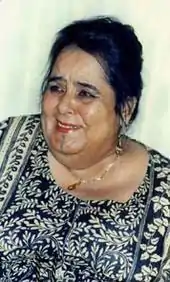Chaïbia Talal
Chaïbia Talal (Arabic: الشعيبية طلال) (1929 – April 2, 2004) was a Moroccan painter.
Chaïbia Talal | |
|---|---|
 | |
| Born | 1929 Chtouka, Morocco |
| Died | April 4, 2004 (aged 74–75) Casablanca, Morocco |
| Nationality | Moroccan |
| Known for | Painting |
| Movement | naive art |
Biography
Chaïbia was born in Choutka, a small village near El Jadida, Morocco in 1929.[1] At the age of 13, she was sent to Casablanca by her parents to marry a 70-year-old man.[2] By the age of 14 she had given birth to a son (Hocein), and by the age of 15 she had become a widow.[3] When her husband died, she worked as a maid to earn money to support herself and her son.[4] Talal was devoted to providing her son with an education, particularly academic literacy, although Talal herself would remain illiterate her entire life.[2] After receiving art supplies from strangers in a dream, she was inspired to begin painting.[5]
Her work was not initially well received in the Moroccan art world.[6] Talal's son became a respected artist in his own right, and in 1965 introduced Talal to the director of the Museum of Modern Art in Paris, Pierre Gaudibert who was impressed by her work.[2] Following this meeting, her works were exhibited at the Goeth-institute in Casablanca and the Museum of Modern Art in Paris in 1966.[6]
Being a self-taught artist, Talal was known for breaking traditional boundaries. Her work is categorized as "Outsider art" which illustrates unconventional ideas by members of non-traditional art movements.[7] She was influenced by the works of artists from the CoBrA painting movement. Her work is also considered by some people, such as journalist Ahmed El Fassi, to be an naïve.[3]
In 2015, Moroccan filmmaker Youssef Britel created biographical movie, entitled Chaïbia. The film was written by David Villemin and Youssef Britel, and starring Saadia Azgoun as Chaïbia Talal.[8]
In 2004, Talal died of a heart attack in Casablanca at the age of 75.[9]
Expositions
- 1966 - Goethe-Institut, Casablanca - Morocco
- 1966 - Solstice gallery, Paris - France
- 1966 - Salon des Surindépendants, Musée d’Art Moderne, Paris - France
- 1969 - "Ecole marocaine", Copenhagen - Denmark
- 1969 - "Kunstkabinett", Frankfurt – Germany
- 1970 - "Les Halles aux Idées", Paris – France
- 1971 - "Dar America", Casablanca, Rabat, Marrakech, Fes, Tangier – Morocco
- 1972 - Ventes aux enchères, Drouot, Paris – France
- 1973 - "L’œil de Bœuf" gallery (CIPAC), Paris – France
- 1974 - "Ivan Spence" gallery, Ibiza – Spain
- 1974 - "Salon des Réalités Nouvelles", Paris – France
- 1976 - "Biennale d’Art", Menton – France
- 1977 - "Salon de Mai", Musée d’Art Moderne, Paris – France
- 1977 - "Salon des Réalités Nouvelles", Paris – France
- 1980 - "Engel gallery", Rotterdam - Netherlands
- 1980 - "Fondation Joan Miró", Barcelona – Spain
Awards
- Gold medal of the French Academic Society for Education and Encouragement. - March 2003.[10]
Further reading
- The artist's voice - by Chaibia Talal
- (in French) Flamand, Alain. Regard sur la peinture contemporaine au Maroc. 221pp.
References
- "Cinéma: Chaïbia, La Paysanne des Arts, en salles le 16 décembre". HuffPost Maghreb. HuffPost Maroc. 1 December 2015. Retrieved 1 April 2018.
- "Chaïbia Talal | artnet". www.artnet.com. Retrieved 2020-12-01.
- Al Hajri, Ibrahim (4 October 2014). "المغربية الشعيبية طلال.. طفولة رسم". Al Jazeera. Al Jazeera. Retrieved 1 April 2018.
- "Tangier National Film Festival: "Chaibia, the peasant arts", a colorful portrait of the painter Chaibia Talal". HuffPost Maghreb. HuffPost Morocco. 3 January 2015. Retrieved 1 April 2018.
- "Chaibiia brought to earth: the colors of the earth in mourning". Le Martin. Le Martin. 4 March 2004. Retrieved 1 April 2018.
- "Chaïbia Talal". Obelisk Art History. Retrieved 2022-03-10.
- Gianaris, Kristen (2020-05-30). "Chaibia Talal, Morocco's Most Famed 20th Century Painter". Morocco World News. Retrieved 2020-12-01.
- "Chaïbia". IMDb. IMDb. Retrieved 1 April 2018.
- "| MoMAA | African Modern Online Art Gallery & Lifestyle Chaibia Talal". MoMAA | African Modern Online Art Gallery & Lifestyle. Retrieved 2020-12-01.
- "The naive art exhibited in Rabat: Chaibia is its own source of inspiration". Le Martin. 2 September 2004. Retrieved 1 April 2018.